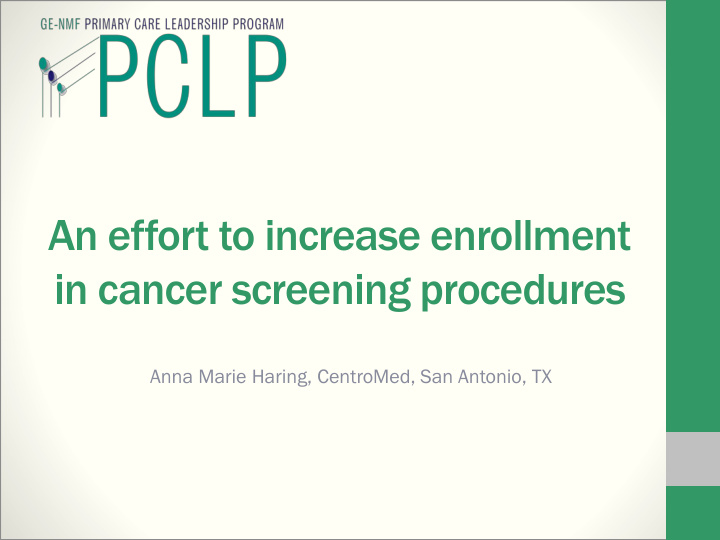



An effort to increase enrollment in cancer screening procedures Anna Marie Haring, CentroMed, San Antonio, TX
Introduction • Cervical and breast cancer are the two most common malignancies in women worldwide. • In the US, colorectal cancer is the second most common malignancy. • Screening procedures for breast, cervical, and colorectal cancer are widely available yet many low-income populations are unable to access them. • This study was done to find a way to increase the number of patients that get referred for mammograms, Pap smears, and colonoscopies.
Background • Current guidelines suggest that women 21-29 get Pap smears every 3 years. Women 30-65 years should receive Pap smears with HPV testing every 5 years. • Hispanic women are more likely to get cervical cancer but they are less likely than non-Hispanic white women to get regular pap smears. • There are many internal and external factors that contribute to the low rate of cancer screening among Hispanic populations. • These reasons include: lack of knowledge about cancer, language barriers, lack of health insurance and primary care. • Many effective models have been developed to provide education to low-income groups in order to increase cancer screening.
Methodology • Setting- meetings were held at CentroMed Southside Clinic. Additional information was obtained by helping with Saturday morning cancer screenings at Walzem clinic. • Target Audience- CentroMed walk-in patients, triage nurses, providers, referral coordinators. • Timeline: • Week 1- Research the obstacles that patients face in accessing cancer screening procedures. • Week 2- Continued to research why people in San Antonio have an especially difficult time in getting screened for cancer. • Week 3- Worked with site mentor at cancer screening clinic. I learned about the various grants that are available to provide free mammograms, pap smears, and colonoscopies. I realized that once patients are signed up to attend this free screening then the chance of them showing up to their appointment is very high. Obstacle to receiving care was identified as being whether a patient gets referred to the free screenings or not. • Week 4- I met with site mentor and lead nurse to construct a form that can be used to increase rates of referrals for cancer screening procedures. I then showed the forms to various site staff to get their suggestions on how to improve it. Week 5- Create executive summary, write report, create powerpoints. Site mentor made • plans to train appropriate staff to fill out form during office visit. • Tools Used- none
Results • PRE-Clinic Form for Triage Nurse • Name____________________________________________DOB_____________AGE______________ • • Chart #__________________________________________ Telephone #__________________________ • US Citizen______________________________________English/Spanish________________________ • Has the Relea ease e of Information ormation Form m been n signed gned? Y / N Women 21-64: Need pap smear every 3-5 years • • Last Pap:___________________Where_________________________Results______________________ • Have you ever had an abnormal Pap smear? Y / N • When ___________________ Where____________________________ Results __________________ • If yes, any cervical Bx or treatment: ________________________________________________________ Hysterectomy: Y / N Reason for Hysto:____________________________________________ • • • Women 40-64: Need mammogram every single year • Last MMG:___________________ Where _______________________Results_____________________ • Have you ever had an abnormal mammogram? Y / N When ___________________ Where____________________________ Results __________________ • • If yes, any Breast Bx done?_______________________________________________________________ • • Men and Women 50-75: Need colonoscopy every 10 years • Has patient ever had a colonoscopy? Y / N When ___________________ Where____________________________ Results __________________ • • • Has patient ever been tested for HIV: Y / N • When_____________________ Results___________________ • • Which procedures are needed? PAP MMG C-Scope HIV • FAX to (---) --- – ---- at end of day
Discussion • It is difficult to determine if this pre-clinic form was a positive development for the site since no research has been performed to show its effectiveness. • There is a need to research how the form is being received after one month of implementation and make adjustments as needed. • Nurses agreed that this form would make their job easier because they can easily see what information is needed. • Providers thought that this form would make it easier to determine if a patient needs to be screened for cancer or not.
Recommendations • All nurses should get interviewed one month after implementing the new form to look for room for improvement. • The lead nurses should keep track of whether all forms are being filled out completely. • The success rate should be measured by comparing the percent of patients that are currently up to date on their screenings with the percentage of patients that are up to date in one year after implementation.
Conclusion • Thanks to the invention of mammograms, Pap smears, and colonoscopies it is easier than ever to identify cancer earlier and to even prevent it. Unfortunately, many low-income populations in the U.S. do not receive these screening procedures at the recommended intervals. I worked with CentroMed to implement a new clinic form that can be used to increase the number of patients that get referred for cancer screenings. Due to the short nature of this program I was unable to test the forms effectiveness.
Acknowledgements I would like to acknowledge Robert Ferrer, MD, Monika Thornton, RN, and Norma Parra, MD for their help with this project.
Recommend
More recommend